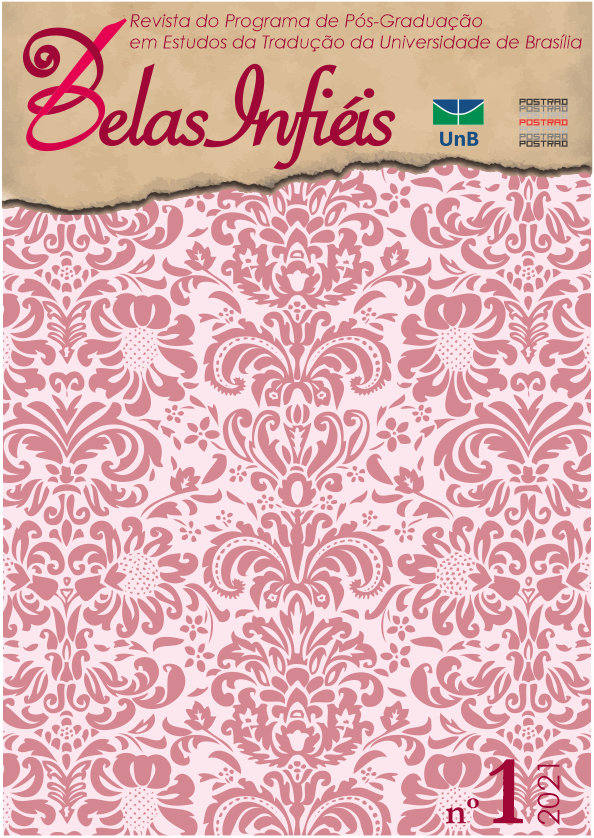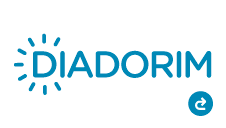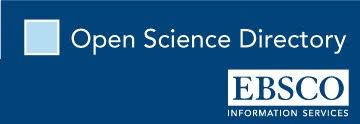Tradução para língua estrangeira: prática, pesquisa e formação no Brasil e no mundo
DOI:
https://doi.org/10.26512/belasinfieis.v10.n1.2021.35294Palavras-chave:
Direcionalidade. Tradução para L2. Versão. Língua inglesa. Formação de tradutores.Resumo
O presente trabalho oferece uma análise crítica do estado da arte sobre a tradução de textos não literários para língua estrangeira (L2), em especial o inglês, como objeto de estudo acadêmico e prática mercadológica. A revisão bibliográfica aqui apresentada procura identificar: (a) de que formas o discurso dentro dos Estudos da Tradução vem se construindo a respeito da tradução para L2; (b) quais as características do inglês que o diferencia de outros idiomas quando se trata da tradução; (c) que questões são abordadas em pesquisas sobre a direcionalidade; e (d) como os dados levantados podem ser aplicados à formação de tradutores, especialmente no Brasil. A superioridade da tradução para L1 vem sendo desafiada dentro dos Estudos da Tradução, devido, entre outros fatores, a pesquisas sobre o assunto oriundas de países de línguas de menor difusão, onde a tradução para L2 é praxe. Como o inglês é a L2 mais falada no mundo, há mais materiais e recursos disponíveis, facilitando a tradução para esse idioma. Estudos mostram que a direcionalidade é apenas uma das variáveis que afetam a qualidade das traduções, outras incluindo a experiência do tradutor e o tipo de texto. No Brasil, há alguns estudos sobre direcionalidade, mas ainda poucas opções de formação em tradução para L2.
Downloads
Referências
ABRATES. O perfil profissional dos tradutores e intérpretes no Brasil. 2015. Disponível em: http://www.slideshare.net/Abrates/o-perfil-profissional-dos-tradutores-e-interpretes-no-brasil-abrates-2015. Acesso em: 22 nov. 2020.
ADAB, Beverly. Translating into a second language: can we, should we? In: ANDERMAN, Gunilla; ROGERS, Margaret (eds.). In and Out of English: For Better, For Worse? Clevedon / Buffalo / Toronto: Multilingual Matters, 2005. p. 227”“241.
ALBIR, Amparo Hurtado (ed.). Researching translation competence by PACTE group. Amsterdam: John Benjamins, 2017.
ANDERMAN, Gunilla; ROGERS, Margaret. English in Europe: For Better, For Worse? In: ANDERMAN, Gunilla; ROGERS, Margaret (eds.) In and Out of English: For Better, For Worse? Clevedon / Buffalo / Toronto: Multilingual Matters, 2005. p. 1”“26.
ARENAS, Ana Guerberof; MOORKENS, Joss. Machine translation and post-editing training as part of a master’s programme. The Journal of Specialised Translation. v. 31. p. 217”“238. 2019
ATA. “Translation ”“ Getting it Right”, encarte da American Translators Association. Traduzido por: Danilo Nogueira, Kelli Semolini e Maria Marques. 2019. Disponível em: https://www.atanet.org/publications/getting_it_right_trans_br.pdf. Acesso em: 29 set. 2019.
APFELTHALER, Matthias. Directionality. In: BAKER, Mona; SALDANHA, Gabriela (eds.) Routledge Encyclopedia of Translation Studies (3ª ed.). Londres/Nova York: Routledge, 2020. p. 152”“155.
BHREATHNACH, Úna. A Best ” Practice Model for Term Planning. Tese de doutorado, Dublin City University, Dublin, 2011.
BOURDIEU, Pierre. The Forms of Capital. In: RICHARDSON, John G. (ed.) Handbook of Theory of Research for the Sociology of Education. Traduzido por: Richard Nice. Westport: Greenwood Press, 1986. p. 241”“258.
BOWKER, Lynne; CIRO, Jairo Buitrago. Machine Translation and Global Research: towards improved machine translation literacy in the scholarly community. Bingley: Emerald Publishing, 2019.
BUCHWEITZ, Augusto; ALVES, Fábio. Cognitive Adaptation in Translation: an interface between language direction, time, and recursiveness in target text production. Letras de Hoje, v. 41, n. 2, 2006. p. 241”“272.
CAMPBELL, Stewart. English Translation and Linguistic Hegemony in the Global Era. In: ANDERMAN, Gunilla; ROGERS, Margaret (eds.) In and Out of English: For Better, For Worse? Clevedon / Buffalo / Toronto: Multilingual Matters, 2005. p. 27”“38.
CHERNOV, Ghelly V. Simultaneous interpretation in Russia: Development of Research and Training. Interpreting v. 4, n. 1, 1999. p. 41”“54.
COMISSÃO EUROPEIA (2010). Redigir com Clareza. Luxemburgo: Serviço das Publicações da União Europeia. Disponível em: http://publications.europa.eu/resource/cellar/725b7eb0-d92e-11e5-8fea-01aa75ed71a1.0023.03/DOC_1. Acesso em: 21 nov. 2020.
COMISSÃO EUROPEIA. Página “Translator profile” do site da Comissão Europeia, s/d. Disponível em: https://ec.europa.eu/info/jobs-european-commission/working-eu/translator-profile_en. Acesso em: 26 out. 2020.
COSTA, Patrícia Rodrigues. A formação de tradutores em instituições de educação superior públicas brasileiras: uma análise documental. Tese de doutorado, Programa de Pós-Graduação em Estudos da Tradução, Universidade Federal de Santa Catarina, Florianópolis, 2018.
CRONIN, Michael. Translation and Globalisation. Londres/Nova York: Routledge, 2003.
DAI, Guangrong; XIAO, Richard. “SL shining through” in translational language: a corpus-based study of Chinese translation of English passives. Translation Quarterly, v. 62, 2011. p. 85”“108.
DW. Incêndios na Amazónia: “governo brasileiro cometeu um erro muito grande”. Reportagem da DW.com. 28 de ago de 2019. Disponível em: https://www.dw.com/pt-002/inc%C3%AAndios-na-amaz%C3%B3nia-governo-brasileiro-cometeu-um-erro-muito-grave/a-50203821. Acesso em: 18 out 2020.
EMERSON, Michael; FLORES, Renato. (orgs.). Enhancing the Brazil-EU Strategic Partnership. Bruxelas: Centre for European Policy Studies, 2013.
FERREIRA, Aline Alves. Direcionalidade em tradução: uma investigação do processamento cognitivo de tradutores profissionais em tradução direta e inversa no par linguístico inglês-português. Dissertação de Mestrado, Programa de Pós-Graduação em Estudos Lingúisticos, Faculdade de Letras, Universidade Federal de Minas Gerais, Belo Horizonte, 2010.
FERREIRA, Aline Alves. Direcionalidade em Tradução: O Papel da Subcompetência Bilíngue em Tarefas de Tradução L1 e L2. Tese de doutorado, Programa de Pós-Graduação em Estudos Linguísticos, Faculdade de Letras, Universidade Federal de Minas Gerais, Belo Horizonte, 2013.
FERREIRA, Aline Alves; GOTTARDO, Alexandra; SCHWEITER, John W. Decision-making processes in direct and inverse translation through retrospective protocols. Translation, Cognition & Behavior, v. 1, n. 1, 2018. p. 98”“118.
FERREIRA, Aline Alves; SCHWEITER, John. Directionality in Translation. In: SCHWEITER, John; FERREIRA, Aline (org.) The Handbook of Translation and Cognition. Hoboken: John Wiley & Sons, 2017. p. 90”“105.
FERREIRA-ALVES, Fernando. Translation Companies in Portugal. Anglo Saxonica, v. 3, n. 3, 2012. p. 232”“263.
FONSECA, Norma Barbosa de Lima. Padrões Prototípicos de Segmentação na descompctação e recompactação de unidades de tradução em tarefas de tradução direta e inversa. Dissertação de Mestrado, Programa de Pós-Graduação em Estudos Lingúisticos, Faculdade de Letras, Universidade Federal de Minas Gerais, Belo Horizonte, 2012.
FONSECA, Norma Barbosa de Lima. Directionality in translation: Investigating prototypical patterns in editingprocedures. Translation & Interpreting, v. 7, n. 1, 2015. p. 111”“125.
GALLEGO-HERNÁNDEZ, Daniel. A vueltas con la traducción inversa especializada en el ámbito profesional. Un estudio basado en encuestas. Trans, v. 18, 2014. p. 229”“238.
GOUANVIC, Jean-Marc. Objectivation, réflexivité et traduction. In: WOLF, Michaela; FUKARI, Alexandra (orgs.), Constructing a Sociology of Translation. Nova York/Amsterdam: John Benjamins, 2007. p. 79”“92.
HEILBRON, Johan; SAPIRO, Gisèle. Outline for a Sociology of Translation. In: WOLF, Michaela; FUKARI, Alexandra (eds.), Constructing a Sociology of Translation. Nova York/Amsterdam: John Benjamins, 2007. p. 93”“105.
HORCAS-RUFIÁN, Sara; KELLY, Dorothy. Inverse (A-B/C) translation education in Spain under the EHEA. Perspectives: Studies in Translation Theory and Practice, v. 28, n. 2, 2019. p. 300”“319.
KOSKINEN, Kaisa. Institutional Illusions. The Translator, v. 6, n. 1, 2000. p. 49”“65.
KOSKINEN, Kaisa. Translating Institutions: an ethnographic study of EU translation. Londres/Nova York: Routledge, 2008.
KUMARAVADIVELU, Ben. A linguística aplicada na era da globalização. In: MOITA LOPES, Luiz Paulo da (ed.). Por uma linguística aplicada indisciplinar, 2006. p. 128”“148.
MARIÑO, Claudia. Reflecting on the dichotomy native-non native speakers in an EFL context. Anagramas - Rumbos y Sentidos de La Comunicación, v. 10, n. 19, 2011. p. 129”“142.
MOITA LOPES, Luiz Paulo da. Uma linguística aplicada mestiça e ideológica: interrogando o campo como linguista aplicado. In: MOITA LOPES, Luiz Paulo da (ed.). Por uma linguística aplicada indisciplinar, 2004. p. 13”“42.
MOITA LOPES, Luiz Paulo da. Linguística aplicada indisciplinar. Entrevista concedida a Cláudia Zilmar da Silva Conceição. Grau Zero ”“ Revista de Crítica Cultural, v. 3, n. 2, 2015. p. 333”“340.
NEWMARK, Peter. A Textbook of Translation. Londres: Longman, 1988.
NORD, Christiane. Defining translation functions: the translation brief as a guideline for the trainee translator. Ilha Do Desterro, v. 33, 1997. p. 41”“55.
OLIVEIRA, Gilvan Müller de. Plurilinguismo no Brasil: repressão e resistência lingüística. Synergies Brésil, v. 7, 2009, p. 19”“26.
PAVLOVIĆ, Nataša. Directionality in Translation and Interpreting Practice: Report on a questionnaire survey in Croatia. FORUM Revue Internationale d’interprétation et de Traduction / International Journal of Interpretation and Translation, v. 5, n. 2, 2007. p. 79”“99.
PENNYCOOK, Alastair. English and the discourses of colonialism. Londres/Nova York: Routledge, 1998.
PENNYCOOK, Alastair. Global Englishes and Transcultural Flows. Londres/Nova York: Routledge, 2007.
PHILLIPSON, Robert. English language spread policy. International Journal of the Sociology of Language, v. 107, 1994. p. 7”“24.
PIRÓTH, Attila. Translation into a non-native language ”“ IAPTI’s survey. January, 2014”“2015, 2015. Disponível em: https://www.iapti.org/files/surveys/2/IAPTI_non-native_report.pdf. Acesso em: 30 ago. 2020.
POKORN, Nike. Challenging the Traditional Axioms: Translation into a non-mother tongue. Amsterdam/Philadelphia: John Benjamins, 2005.
ROGERS, Margaret. Specialised Translation: shedding the non-literary tag. Basingstoke: Palgrave Macmillan, 2015.
SÁNCHES-GIJÓN, Pilar; TORRES-HOSTENCH, Olga. MT Post-editing into the mother tongue or into a foreign language? Spanish-to-English MT translation output post-edited by translation trainees. In: Third Workshop on Post-editing Techniques and Practices. O’BRIEN, S; SIMARD, M; SPECCIA, L (eds.). The 11th Conference of the Association for Machine Translation in the Americas. Vancouver, 22”“26 out., 2014. Disponível em: http://www.amtaweb.org/AMTA2014Proceedings/AMTA2014Proceedings_PEWorkshop_final.pdf. Acesso em: 13 nov. 2014.
SARAIVA, Miriam Gomes. Brazil’s Rise and Its Soft Power Strategy in South America. In: GARDINI, Gian Luca; ALMEIDA, Maria Hermínia Tavares de (orgs). Foreign Policy Responses to the Rise of Brazil Balancing Power in Emerging States. Basingstoke: Palgrave, 2014. p. 46”“61.
SILVA, Igor Antônio Lourenço da. An interactional expertise-based approach to specialized inverse translation. Tradução em Revista, v. 26, n. 1, 2019. p. 86”“98.
STEWART, Dominic. From Pro Loco to Pro Globo Translating into English for an International Readership. The Interpreter and Translator Trainer, v. 7, n. 2, 2013. p. 217”“234.
TAGNIN, Stella E. O. A Linguística de corpus na e para a tradução. In: VIANNA, Vander;
TAGNIN, Stella E. O. (orgs.). Corpora na tradução. São Paulo: Hub Editorial, 2015. p. 19”“56
WANG, Baorong. Translation Practices and the Issue of Directionality in China. Meta, v. 56, n. 4, 2011. p. 896”“914.
WHYATT, Boguslawa. In search of directionality effects in the translation process and in the end product. Translation, Cognition & Behavior, v. 2, n. 1, 2019. p. 79”“100.
WHYATT, Boguslawa; KOSCIUCZUK, Tomasz. Translation into a non-native language: the double life of the native-speakership axiom. mTm Translation Journal, v. 5, 2013. p. 60”“79.
Downloads
Publicado
Como Citar
Edição
Seção
Licença
Copyright (c) 2021 CC BY

Este trabalho está licenciado sob uma licença Creative Commons Attribution 4.0 International License.
Dado ao acesso público desta revista, os textos são de uso gratuito, com obrigatoriedade de reconhecimento da autoria original e da publicação inicial nesta revista
A revista permitirá o uso dos trabalhos publicados para fins não comerciais, incluindo direito de enviar o trabalho para bases de dados de acesso público. As contribuições publicadas são de total e exclusiva responsabilidade dos autores.
Os autores, ao submeterem trabalhos para serem avaliados pela revista Belas Infiéis, mantêm os direitos autorais e concedem à revista o direito de primeira publicação, sendo o trabalho licenciado sob a Creative Commons Attribution License Atribuição 4.0 Internacional (CC BY 4.0).



















